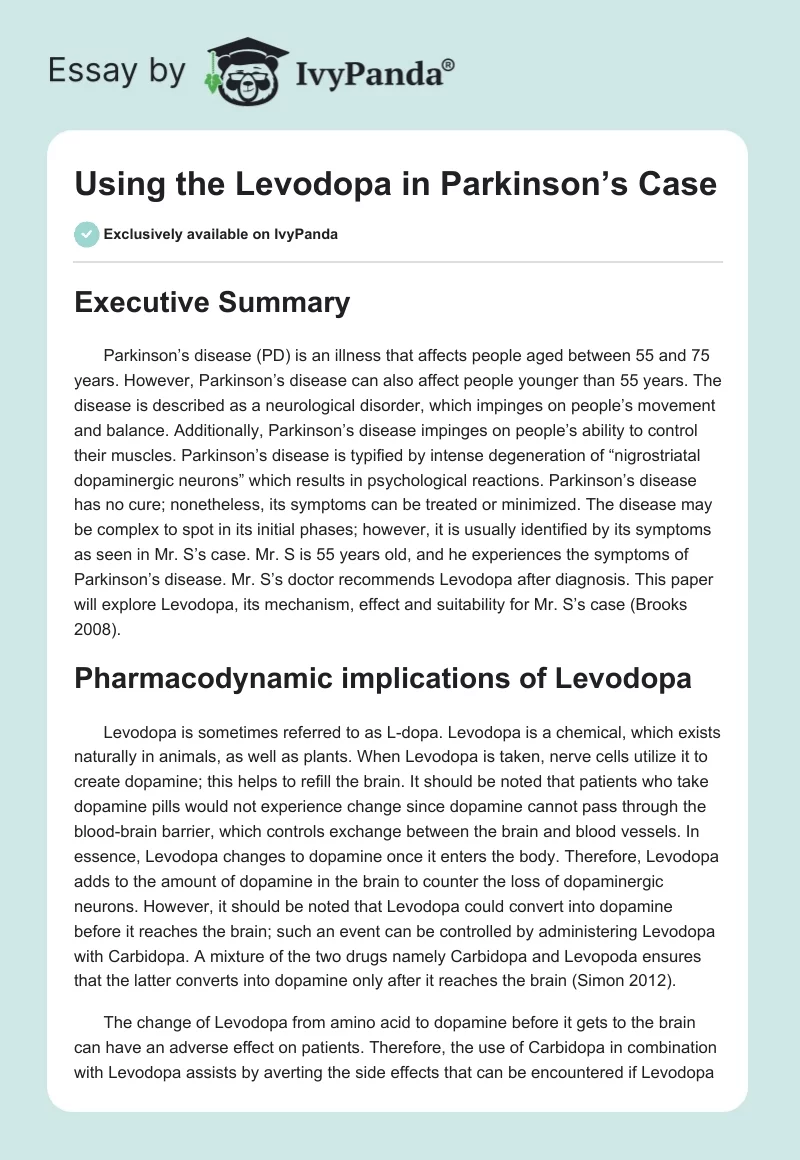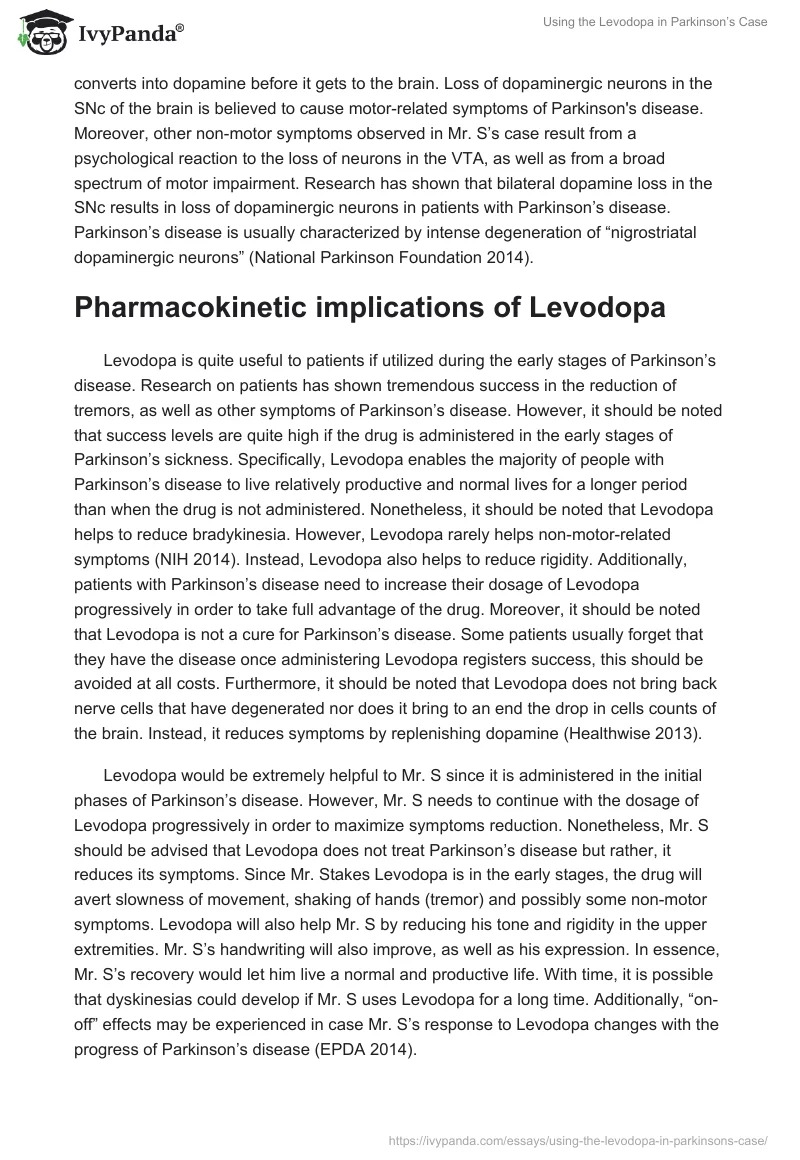Executive Summary
Parkinson’s disease (PD) is an illness that affects people aged between 55 and 75 years. However, Parkinson’s disease can also affect people younger than 55 years. The disease is described as a neurological disorder, which impinges on people’s movement and balance. Additionally, Parkinson’s disease impinges on people’s ability to control their muscles. Parkinson’s disease is typified by intense degeneration of “nigrostriatal dopaminergic neurons” which results in psychological reactions. Parkinson’s disease has no cure; nonetheless, its symptoms can be treated or minimized. The disease may be complex to spot in its initial phases; however, it is usually identified by its symptoms as seen in Mr. S’s case. Mr. S is 55 years old, and he experiences the symptoms of Parkinson’s disease. Mr. S’s doctor recommends Levodopa after diagnosis. This paper will explore Levodopa, its mechanism, effect and suitability for Mr. S’s case (Brooks 2008).
Pharmacodynamic implications of Levodopa
Levodopa is sometimes referred to as L-dopa. Levodopa is a chemical, which exists naturally in animals, as well as plants. When Levodopa is taken, nerve cells utilize it to create dopamine; this helps to refill the brain. It should be noted that patients who take dopamine pills would not experience change since dopamine cannot pass through the blood-brain barrier, which controls exchange between the brain and blood vessels. In essence, Levodopa changes to dopamine once it enters the body. Therefore, Levodopa adds to the amount of dopamine in the brain to counter the loss of dopaminergic neurons. However, it should be noted that Levodopa could convert into dopamine before it reaches the brain; such an event can be controlled by administering Levodopa with Carbidopa. A mixture of the two drugs namely Carbidopa and Levopoda ensures that the latter converts into dopamine only after it reaches the brain (Simon 2012).
The change of Levodopa from amino acid to dopamine before it gets to the brain can have an adverse effect on patients. Therefore, the use of Carbidopa in combination with Levodopa assists by averting the side effects that can be encountered if Levodopa converts into dopamine before it gets to the brain. Loss of dopaminergic neurons in the SNc of the brain is believed to cause motor-related symptoms of Parkinson’s disease. Moreover, other non-motor symptoms observed in Mr. S’s case result from a psychological reaction to the loss of neurons in the VTA, as well as from a broad spectrum of motor impairment. Research has shown that bilateral dopamine loss in the SNc results in loss of dopaminergic neurons in patients with Parkinson’s disease. Parkinson’s disease is usually characterized by intense degeneration of “nigrostriatal dopaminergic neurons” (National Parkinson Foundation 2014).
Pharmacokinetic implications of Levodopa
Levodopa is quite useful to patients if utilized during the early stages of Parkinson’s disease. Research on patients has shown tremendous success in the reduction of tremors, as well as other symptoms of Parkinson’s disease. However, it should be noted that success levels are quite high if the drug is administered in the early stages of Parkinson’s sickness. Specifically, Levodopa enables the majority of people with Parkinson’s disease to live relatively productive and normal lives for a longer period than when the drug is not administered. Nonetheless, it should be noted that Levodopa helps to reduce bradykinesia. However, Levodopa rarely helps non-motor-related symptoms (NIH 2014). Instead, Levodopa also helps to reduce rigidity. Additionally, patients with Parkinson’s disease need to increase their dosage of Levodopa progressively in order to take full advantage of the drug. Moreover, it should be noted that Levodopa is not a cure for Parkinson’s disease. Some patients usually forget that they have the disease once administering Levodopa registers success, this should be avoided at all costs. Furthermore, it should be noted that Levodopa does not bring back nerve cells that have degenerated nor does it bring to an end the drop in cells counts of the brain. Instead, it reduces symptoms by replenishing dopamine (Healthwise 2013).
Levodopa would be extremely helpful to Mr. S since it is administered in the initial phases of Parkinson’s disease. However, Mr. S needs to continue with the dosage of Levodopa progressively in order to maximize symptoms reduction. Nonetheless, Mr. S should be advised that Levodopa does not treat Parkinson’s disease but rather, it reduces its symptoms. Since Mr. Stakes Levodopa is in the early stages, the drug will avert slowness of movement, shaking of hands (tremor) and possibly some non-motor symptoms. Levodopa will also help Mr. S by reducing his tone and rigidity in the upper extremities. Mr. S’s handwriting will also improve, as well as his expression. In essence, Mr. S’s recovery would let him live a normal and productive life. With time, it is possible that dyskinesias could develop if Mr. S uses Levodopa for a long time. Additionally, “on-off” effects may be experienced in case Mr. S’s response to Levodopa changes with the progress of Parkinson’s disease (EPDA 2014).
Discussion
As mentioned above, Levodopa is utilized mainly to replenish dopamine in the brain. Levodopa can have various side effects on patients. The side effects encountered in the initial phases are vomiting, restlessness, as well as drowsiness. Additionally, the drug can cause low blood pressure in patients. Other side effects include nausea and dyskinesias (MedicineNet 2014). When an overdose of Levodopa is taken, the patient can sometimes experience psychosis or mirages. Moreover, large doses of Levodopa for a prolonged period have the propensity of causing twitching and writhing movements, among others. In this regard, Levodopa dosage is usually minimized to curb dyskinesias. On the other hand, minimized doses also result in the re-emergence of symptoms of PD illness. Patients suffering from Parkinson’s disease are encouraged to establish close links with their doctors to ensure that they strike the right balance between Levodopa and its side effects. It is also imperative to note that patients undertaking Parkinson’s disease drugs may experience its symptoms before the initial dose and after the dose wears off (PDSUK 2014).
Some patients may experience the “wearing-off” effect, which happens when the time of effectiveness of Levodopa shortens. Moreover, the “on-off” can also be experienced by the patient. One way of reducing Levodopa side effects is to take small portions frequently. In addition, Patients must not stop taking Levodopa without the doctor’s advice as this can result in severe side effects such as paralysis and breathing difficulty. To register desired outcomes, Levodopa should be administered with Carbidopa, which helps to ensure that the former converts into dopamine only after reaching the brain. Other treatment methods have also been developed for the different stages of Parkinson’s disease. One of the drugs utilized for reducing symptoms is COMT inhibitors. Additionally, anticholinergic drugs can also be used, as well as Amantadine. In addition to MAO-B inhibitors, PD patients have also been encouraged to use direct dopamine agonists. Based on Mr. S’s symptoms, Levodopa is the best choice. However, it should be administered with Carbidopa. Alternatively, a combination of the two drugs known as Carbidopa-Levodopa can be utilized to ensure that Levodopa is converted in the brain (AHFS 2014).
Conclusion
Parkinson’s disease has no cure. However, its symptoms can be relieved through medication. Mr. S’s symptoms were a clear indication of the early stages of Parkinson’s disease. Moreover, the doctors’ prescription of Levodopa for a start was correct as it had the best chances of reducing Mr. S’s symptoms. However, it was also necessary that the progress of the disease be monitored closely to minimize other associated side effects of Levodopa. For instance, drugs like Amantadine may be used if Mr. S develops dyskinesias. Furthermore, Levodopa should be administered in combination with Cardidopa to reduce symptoms, which may result from pre-conversion of Levodopa.
Reference List
AHFS 2014, Levodopa and Carbidopa, Web.
Brooks, D 2008, ‘Optimizing Levodopa therapy for Parkinson’s disease with Levodopa/Carbidopa/entacapone: implications from a clinical and patient perspective’, Neuropsychiatr Dis Treat., vol. 4, no. 1, pp. 39-47.
EPDA 2014, Levodopa, Web.
Healthwise 2013, Parkinson’s Disease Health Center: Levodopa Medicines for Parkinson’s Disease, Web.
MedicineNet 2014, Levodopa-Carbidopa, Sinemet, Sinemet CR, Parcopa, Web.
National Parkinson Foundation 2014, Carbidopa/ Levodopa, Web.
NIH 2014, NIH Senior Health: Parkinson’s disease, Web.
PDSUK 2014, Levodopa, Web.
Simon, H 2012, Parkinson’s disease, Web.


